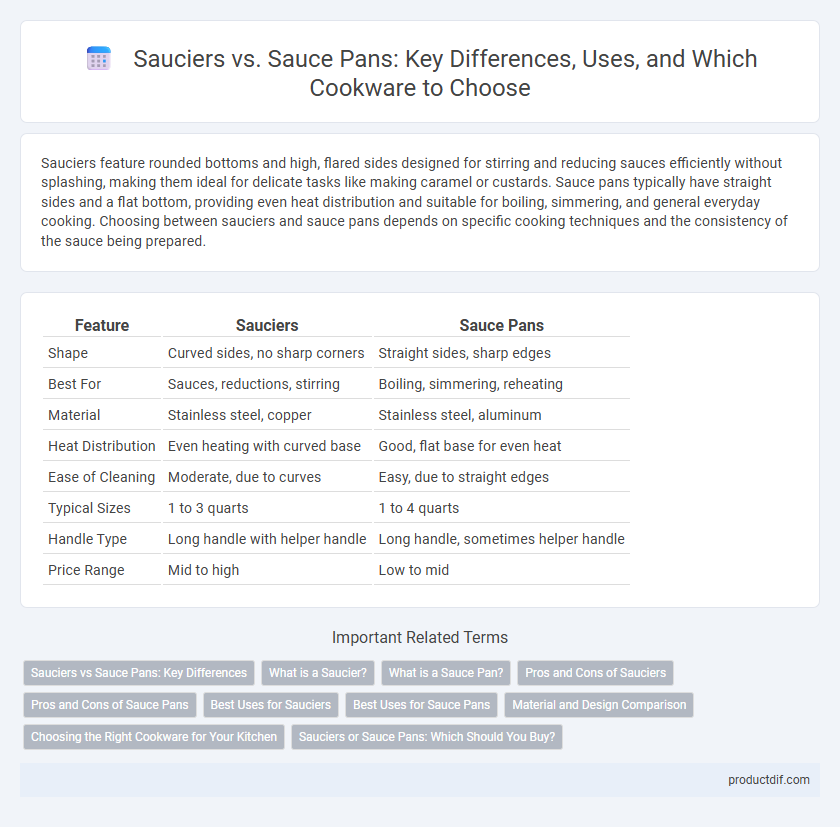Sauciers feature rounded bottoms and high, flared sides designed for stirring and reducing sauces efficiently without splashing, making them ideal for delicate tasks like making caramel or custards. Sauce pans typically have straight sides and a flat bottom, providing even heat distribution and suitable for boiling, simmering, and general everyday cooking. Choosing between sauciers and sauce pans depends on specific cooking techniques and the consistency of the sauce being prepared.
Table of Comparison
| Feature | Sauciers | Sauce Pans |
|---|---|---|
| Shape | Curved sides, no sharp corners | Straight sides, sharp edges |
| Best For | Sauces, reductions, stirring | Boiling, simmering, reheating |
| Material | Stainless steel, copper | Stainless steel, aluminum |
| Heat Distribution | Even heating with curved base | Good, flat base for even heat |
| Ease of Cleaning | Moderate, due to curves | Easy, due to straight edges |
| Typical Sizes | 1 to 3 quarts | 1 to 4 quarts |
| Handle Type | Long handle with helper handle | Long handle, sometimes helper handle |
| Price Range | Mid to high | Low to mid |
Sauciers vs Sauce Pans: Key Differences
Sauciers feature rounded bottoms and sloping sides designed for stirring sauces and reducing liquids more efficiently, whereas sauce pans have straight sides and a flat bottom ideal for boiling and simmering. The curved interior of sauciers allows for better whisking and prevents ingredients from catching, making them perfect for delicate sauces and reductions. Sauce pans typically offer better heat distribution on flat stovetops but lack the maneuverability and surface area for vigorous stirring that sauciers provide.
What is a Saucier?
A saucier is a specialized type of cookware designed with rounded, sloping sides and a wide base, ideal for making sauces, reductions, and emulsions that require constant whisking and stirring. Unlike traditional saucepans with straight sides, sauciers provide better surface contact for even heat distribution and allow easier access for stirring tools, preventing ingredients from getting trapped in corners. Professional chefs favor sauciers for their versatility in preparing delicate sauces, risottos, and custards, which demand precision and gentle heat control.
What is a Sauce Pan?
A saucepan is a versatile cookware piece characterized by its tall, straight sides and a flat bottom, designed primarily for simmering, boiling, and making sauces. Typically made from materials like stainless steel, aluminum, or copper, saucepans offer even heat distribution and are equipped with a long handle for easy maneuvering. Their depth and size make them ideal for tasks that require cooking liquids, such as preparing soups, boiling pasta, or reducing sauces.
Pros and Cons of Sauciers
Sauciers feature rounded bottoms and sloping sides designed for easier stirring, reducing food sticking and burning, which makes them ideal for delicate sauces and reductions. Their shape enables better heat distribution but limits their suitability for tasks requiring a flat surface, such as searing or frying. However, sauciers typically have a higher price point and may take up more storage space compared to traditional saucepans.
Pros and Cons of Sauce Pans
Sauce pans offer versatile cooking with their straight sides and tight-fitting lids, ideal for simmering, boiling, and making sauces, but their shape can limit stirring and reduction efficiency compared to sauciers. They are typically easier to stack and store, yet their narrower bottom surface can result in uneven heat distribution for some recipes. While sauce pans are generally more affordable and widely available, they may lack the specialized design that enhances control and stirring in sauciers.
Best Uses for Sauciers
Sauciers feature rounded bottoms and flared sides, making them ideal for tasks requiring constant stirring, such as making sauces, reductions, and custards. Their shape prevents ingredients from sticking in corners, ensuring even heat distribution and smooth texture. This design excels for delicate preparations and emulsifications where controlled heat and thorough mixing are crucial.
Best Uses for Sauce Pans
Sauce pans excel at boiling, simmering, and making sauces due to their straight sides and tight-fitting lids that retain moisture and heat efficiently. Ideal for tasks like cooking grains, steaming vegetables, and reheating soups, their even heat distribution supports precise temperature control. Available in various sizes and materials, sauce pans offer versatility for everyday kitchen use where liquid-based cooking is required.
Material and Design Comparison
Sauciers feature rounded, sloped sides ideal for stirring and reducing sauces, crafted commonly from stainless steel or copper for even heat distribution. Sauce pans possess straight sides and a flat bottom, often made from aluminum or non-stick materials to ensure quick and uniform cooking. The choice between sauciers and sauce pans hinges on their design tailored for specific cooking techniques and the thermal properties of their materials.
Choosing the Right Cookware for Your Kitchen
Sauciers feature rounded bottoms and sloping sides, ideal for reducing sauces with constant stirring and preventing residue buildup, while sauce pans offer straight sides perfect for boiling and simmering liquids. Selecting the right cookware depends on the intended cooking techniques; sauciers excel in emulsifying and whisking, whereas sauce pans provide versatile options for multitasking in the kitchen. Prioritize materials like stainless steel or copper with a thick base to ensure even heat distribution and durability in either cookware choice.
Sauciers or Sauce Pans: Which Should You Buy?
Sauciers feature rounded bottoms and sloped sides, making them ideal for stirring sauces and reducing liquids evenly, while saucepans typically have straight sides and are better for boiling and simmering. Choosing between a saucier and a saucepan depends on your cooking style; sauciers excel in tasks requiring constant stirring and reduction, whereas saucepans offer versatility for a broader range of cooking methods. Investing in a high-quality copper saucier provides superior heat conductivity for delicate sauces, whereas stainless steel saucepans are durable and suitable for everyday use.
Sauciers vs Sauce Pans Infographic

 productdif.com
productdif.com